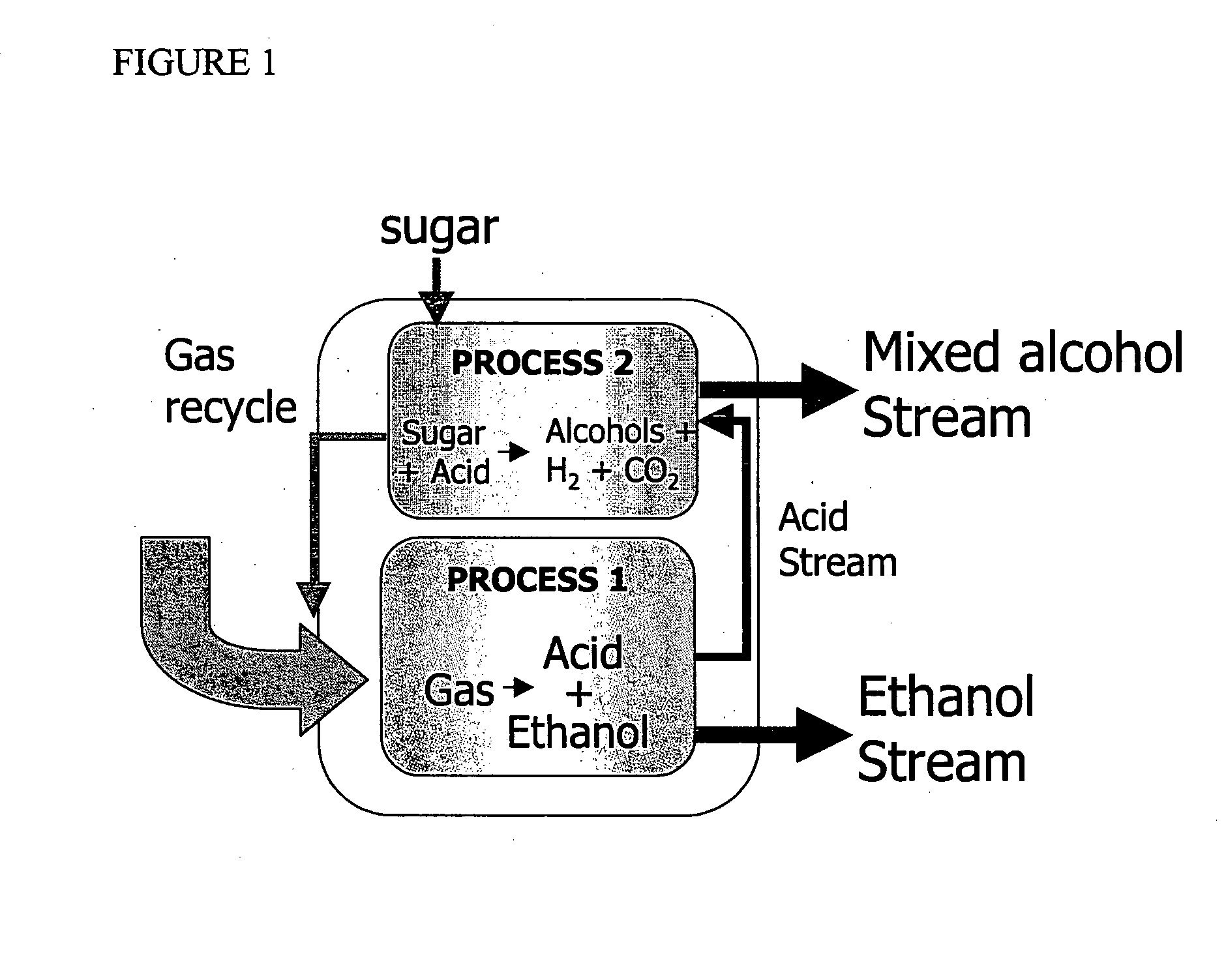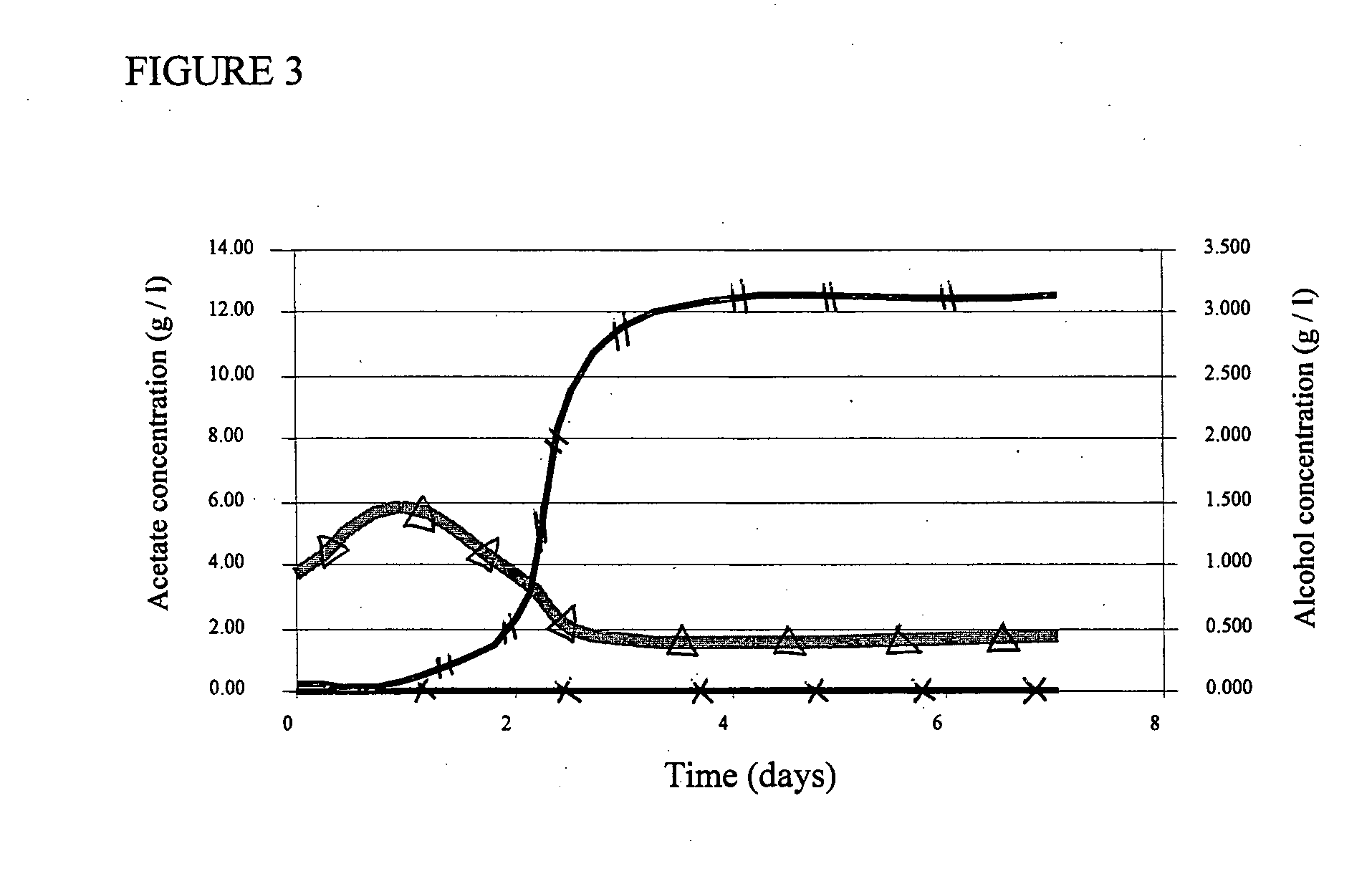Alcohol production process
- Summary
- Abstract
- Description
- Claims
- Application Information
AI Technical Summary
Benefits of technology
Problems solved by technology
Method used
Image
Examples
example 1
[0113]The aim of the following set of experiments was to demonstrate that acetate, a co-product formed during microbial gas-to-ethanol production with gas mixtures lacking hydrogen, could be used as a co-substrate in a second microbial system that produced hydrogen. The effect of acetate addition as a co-substrate increases the volume of alcohol (measured as butanol) production in the hydrogen producing culture. The hydrogen, when recycled to a gas-to-ethanol production unit, resulted in improved gas-to-ethanol performance.
[0114]The research goal was to demonstrate that the acetate co-product could be used as a co-substrate, with glucose in the production of alcohol, primarily butanol, in a fermentation that produced hydrogen gas as a co-product, and the hydrogen could be used to improve the gas-to-ethanol reaction with Clostridium autoethanogenum growing on otherwise hydrogen-free gas mixtures. Acetate was added to serum bottle cultures of Clostridium acetobutylicum culture, and th...
example 2
[0132]The aim of the following experiment was to demonstrate that: 1) butyrate formed during microbial fermentation of a carbon monoxide containing substrate, could be used as a co-substrate in a second microbial system that produced hydrogen; and / or, 2) butyrate and acetate, co-products formed during microbial fermentations of a substrate to ethanol and / or butanol, could both be used as co-substrates in a second microbial system that produced hydrogen. The effect of butyrate, or butyrate and acetate, addition as co-substrate(s) increases the volume of butanol production in the hydrogen producing culture.
Methods
[0133]Growth of Clostridium acetobutylicum strain 824 (accession no. DSM 792, DSMZ, Germany) involved methods familiar to those experienced in the art of using this bacterial species. Cells were maintained in 234 ml serum bottles in 50 mL of media with 184 mL headspace on basal media containing butyrate, or acetate and butyrate, at increasing concentrations ranging from 0 to ...
example 3
[0144]The following experiment was designed to demonstrate that: 1) the addition of hydrogen gas could be used to improve the gas-to-ethanol reaction with Clostridium autoethanogenum growing on a substrate containing carbon monoxide; and, 2) the addition of hydrogen gas could be used to improve the gas-to-butyrate reaction with Clostridium tetanomorphum (DSM 528) growing on a substrate containing carbon monoxide.
Methods
[0145]Growth of Clostridium autoethanogenum was undertaken as per example 1. Clostridium tetanomorphum (DSM 528) cells were maintained in maintained in 234 ml serum bottles in 50 mL of media (media as per example 1 for Clostridium autoethanogenum, supplemented with 1 g / l Yeast Extract) with 184 mL headspace (95% CO in CO2, 30 psig overpressure). Serum bottles were gas tight with all additions of media, gases and culture through the use of syringes and needles. Serum bottles were continuously agitated to increase gas-to-liquid mass transfer.
[0146]Acetate, butyrate, but...
PUM
 Login to View More
Login to View More Abstract
Description
Claims
Application Information
 Login to View More
Login to View More - R&D
- Intellectual Property
- Life Sciences
- Materials
- Tech Scout
- Unparalleled Data Quality
- Higher Quality Content
- 60% Fewer Hallucinations
Browse by: Latest US Patents, China's latest patents, Technical Efficacy Thesaurus, Application Domain, Technology Topic, Popular Technical Reports.
© 2025 PatSnap. All rights reserved.Legal|Privacy policy|Modern Slavery Act Transparency Statement|Sitemap|About US| Contact US: help@patsnap.com



